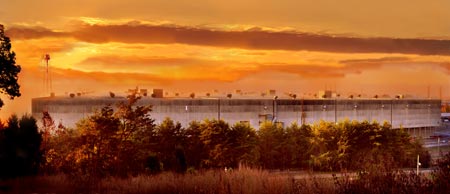
ORISE’s completion of environmental characterization at ORNL is a Recovery Act success

This 2.8 million-square-foot facility known as K-33 was formerly used to house a uranium-enrichment operation during the Manhattan Project. The superstructure was one of three dozen facilities ORISE characterized under the American Recovery and Reinvestment Act—an effort that proved to be challenging due to the complexity of the facilities and the project’s accelerated timeline. Photo courtesy of DOE.
Over the past year and a half, funding from the American Recovery and Reinvestment Act (ARRA) has made its way into Oak Ridge, Tenn. That has meant that the Oak Ridge Institute for Science and Education (ORISE), which is managed by Oak Ridge Associated Universities, has been very busy assisting the U.S. Department of Energy (DOE) in dramatically reducing the number of high-risk facilities located throughout the Oak Ridge Reservation.
A major milestone was reached this summer when ORISE completed radiological and chemical characterization sampling of 34 structures at Oak Ridge National Laboratory and of the K-33 superstructure, a 2.8 million-square-foot facility located at the former Oak Ridge Gaseous Diffusion Plant. The facilities, many of which dated back to the Manhattan Project, were deteriorating and deemed non-essential to DOE’s future mission.
According to ORISE Director for Independent Environmental Assessment and Verification Sarah Roberts, when a structure is slated for demolition, a characterization must be performed to assess the activities that occurred in that building, what kind of chemicals or hazardous substances may have been stored or processed there, and also how best to safely remove and dispose of those materials.
“...[using ORISE’s environmental characterization] saved us probably 6 to 12 months worth of effort. ... We wouldn’t be where we are today if we had not been able to get a leg up on this using ORISE.” -Lee McGetrick, DOE Recovery Act Portfolio Manager
The ORNL characterization work included the collection of 1,120 samples from nuclear reactor coolant water systems, storage tanks, laboratory research facilities, shielded radiation containment chambers known as “hot cells,” offices and maintenance shops. The team that surveyed K-33 collected 464 samples from a number of walls, support columns and basement-areas within the massive structure, which reached across a combined 66 acres.
“The work at ORNL and K-33 was unique due to the complexity of the facilities and the extremely accelerated timeline,” Roberts said. “Our team created a process to improve the efficiency of sample collection in order to ensure field work was completed prior to the mobilization of the [decontamination and decommissioning] contractor—a key milestone for our DOE customer.”
In addition to conducting historical research of the facilities, ORISE also anticipated that some of the radiological contaminants they would have to contend with might involve mixed fission or activation products, uranium, and associated radionuclides and materials used in the fabrication of nuclear weapons known as “transuranics.” Possible chemical constituents involved beryllium, asbestos, lead, PCBs, as well as other heavy metals and organic compounds.